Alignment in Dungeons & Dragons is used to define a creature’s moral and ethical perspective. This foundational concept has been part of the game’s DNA since D&D’s earliest days, and it is still an integral part of the 2024 Core Rulebooks. In the 2024 Player’s Handbook, the iconic D&D alignment chart is a roleplaying tool used in character creation, while the 2024 Dungeon Master’s Guide helps DMs use alignment to run monsters and explains how this fundamental concept manifests itself in D&D’s cosmology.
Let’s explore how alignment fits into the 2024 core rules and how you can use it as a tool to serve you and your game!
- What is Alignment in D&D?
- Using Alignment When Creating Characters
- Morality for Player Characters
- Using Alignment as a Dungeon Master
- What Are the Nine Alignments in D&D?
What is Alignment in D&D?
Alignment in D&D broadly describes a character’s ethical attitudes and ideals based on two key factors: their morality and their tendencies towards order. The intersection of these two concepts creates the D&D alignment chart, a set of nine different alignments that reflect typical behaviors across the spectrum of good and evil, and law and chaos.
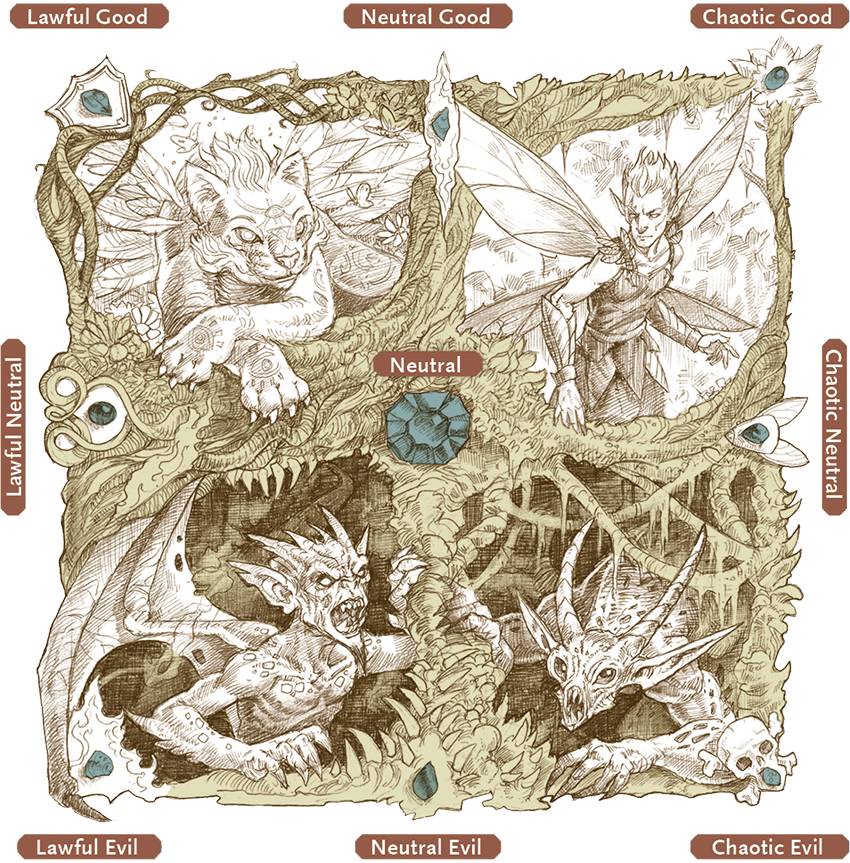
Using Alignment When Creating Characters
When creating a new character in D&D, the choice of your character’s alignment is a decision you make after you’ve selected their class, origin, and ability scores. While your alignment doesn’t come with any specific mechanical effects, it helps you combine the elements of your character into their personality for you to roleplay.
Actions Dictate Alignment
When selecting an alignment for your character, don’t consider it a restriction that defines what your character can or can’t do. Instead, imagine it as a description of their actions and how they approach the world.
So, if you’re playing a Fighter with the Guard background who adheres to the regimens and structure of their old life, you might consider them lawful. But if they left that work because it was too restrictive and they yearned to roam free, they might be chaotic instead.
Alignment Can Change
Character alignments can change over time. For example, in Dungeons & Dragons: Honor Among Thieves, Edgin's backstory begins with him following a strict code as a member of the benevolent Harpers organization, meaning he’d have a Lawful Good alignment.
Eventually, he rejected that code for personal profit and later survival, so you might view him as Chaotic Neutral. By the end of the film, and in his official Thieves’ Gallery stat block, he’s listed as having a Chaotic Good alignment.
Morality for Player Characters
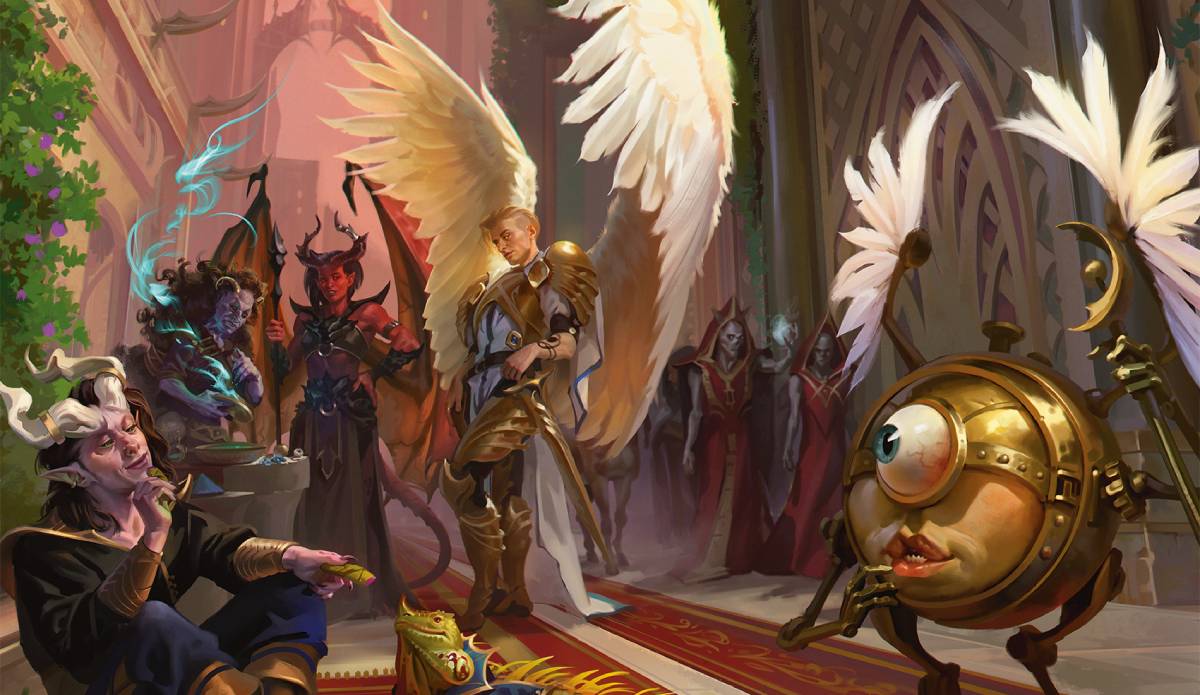
D&D is a game of heroic fantasy roleplaying. As such, the default assumption is that player characters will have a good or neutral alignment. The 2024 Player’s Handbook suggests that if, as a player, you want to be an evil-aligned character, you should discuss it with your DM first.
Good and Evil Can Cooperate
With DM permission, you can bring an evil character into a game. When playing an evil-aligned character in a party of good-aligned characters, it’s important to remember that despite having different motives, you, as players, should share the same goal while playing. Your intent in making an evil character shouldn’t be to consistently disrupt and work against your group’s ability to mutually enjoy the game.
Good and evil characters can cooperate and frequently do in all kinds of stories. A Chaotic Good vampire hunter might work with a Lawful Evil vampire to destroy a common enemy when it serves their mutual interest. A swamp-dwelling Neutral Evil Ogre might begrudgingly join a Neutral Good donkey on a quest, as long as it gets the disruptive fairytale creatures out of his home. And who knows, that ogre’s actions in the face of strife may reveal that he now has a Chaotic Good alignment.
There are ways to make conflicting moralities work well together and form interesting narratives, but it does require the players to buy into that shared story.
Using Alignment as a Dungeon Master
As a Dungeon Master, alignment can be a useful tool for getting into the mindset of your creatures. When you’re running an NPC based on the information in their stat block, their alignment can prompt you on their starting attitude towards the party and how to roleplay them during your sessions.
When you’re tracking a lot of different characters, it can be helpful to glance at a stat block and decide whether you should roleplay a creature as a scheming trickster or as a kindhearted soul who genuinely just wants to help out the players.
Similarly, understanding alignment can serve as a useful shorthand when creating your own NPCs. For instance, is your villain Lawful Evil, pursuing their ambitions within the structured hierarchy of a kingdom? Or are they Chaotic Evil, a vengeful outsider leading an army determined to raze the kingdom’s capital? Is a potential ally Lawful Neutral and will only give aid if the party makes a compelling case? Or are they a Lawful Good creature who will support any worthy cause?
Like with your players’ characters, though, an individual's actions can stray from the tenets of their alignment, and their alignment can change! If you initially envision someone as a Lawful Evil character and the players topple their plans, they might later return seeking revenge as a Chaotic Evil character. Or, in a more extreme case, a character who was Lawful Evil earlier in the campaign might have a change of heart and shift to Neutral or even Chaotic Good if the characters’ actions make them see the error of their ways.
What Are the Nine Alignments in D&D?
Let’s take a look at each of the alignments in the D&D alignment chart and what they mean for a character.
Lawful Good
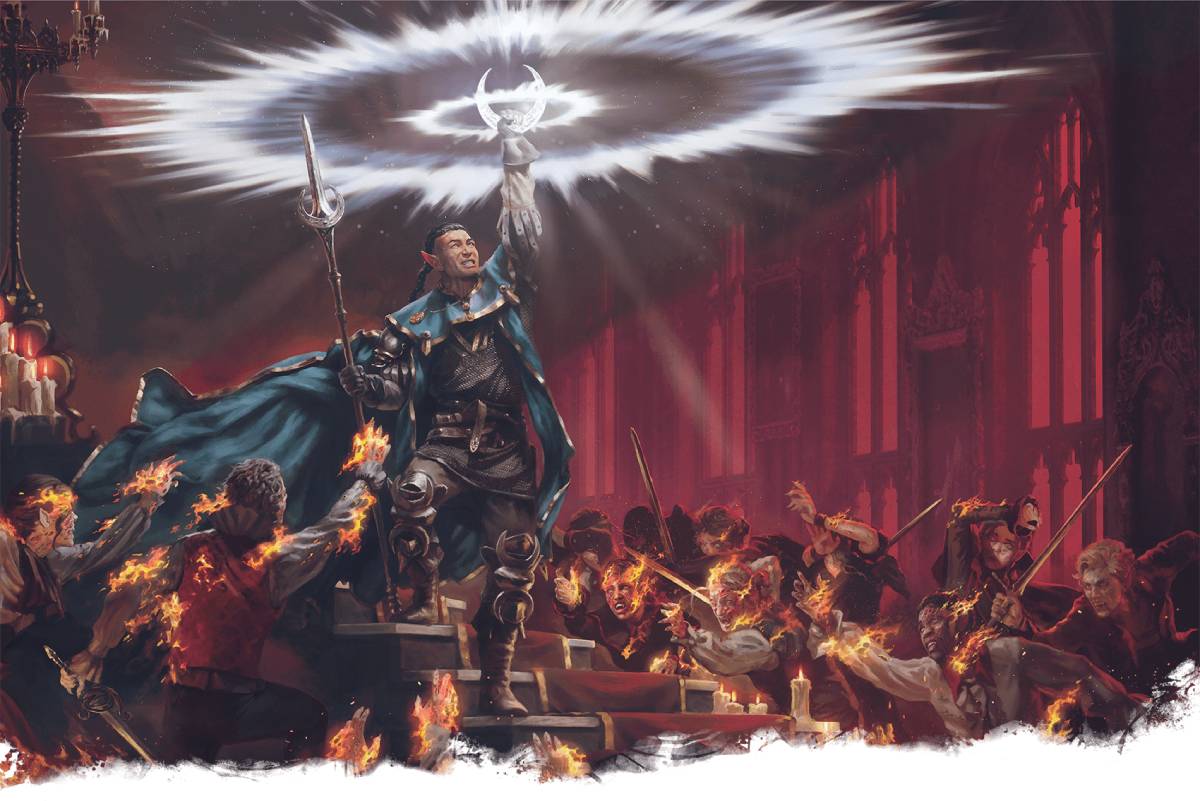
A Lawful Good character feels a duty to do what society considers to be the right thing. They tend to follow rules while also having compassion and concern for their fellow beings. A Lawful Good character might be beholden to the laws of the land, but they may instead follow a strict moral code imparted to them by their organization.
Xenk Yendar in Dungeons & Dragons: Honor Among Thieves is a Lawful Good character. He lives according to his Paladin’s oath to protect the innocent and vanquish evil. He temporarily works with the more roguish protagonists of the film, while always urging them to walk a more valiant path such as his own.
Neutral Good
A Neutral Good character does the best they can, working within the rules when they can but not feeling restricted by them. They still care about helping others, and will generally still find noble causes appealing and necessary.
Another character from Dungeons & Dragons: Honor Among Thieves, Doric, is an example of a Neutral Good character. She doesn’t trust humans because of her past as a tiefling and isn’t particularly concerned with their laws, especially the Lord of Neverwinter’s. But she cares deeply about the Emerald Enclave and is willing to join Edgin’s party and their quest to help protect it.
Chaotic Good
A Chaotic Good character lets their conscience be their guide, fighting injustice and protecting others with little regard for outside expectations. A Chaotic Good character might frequently and excitedly commit crimes to serve what they see as the greater good. Characters leading a rebellion against totalitarian or tyrannical leaders are usually considered Chaotic Good.
Robin Hood is a classic example of a Chaotic Good character. In most Robin Hood stories, Robin and his Merry Men steal from the corrupt leaders of Nottingham and return their takings to the suffering people of the town.
Lawful Neutral
A Lawful Neutral character follows their laws or traditions without regard for inherent morality. For a Lawful Neutral creature, adherence to the rules is more important than the demands of those in need or the temptations of evil.
At the start of the Baldur’s Gate 3, Lae’zel is a Lawful Neutral character. She is devoted fully to the tenets of Githyanki society and the requirements of her queen. While she might be perceived as cruel to other characters, she’s simply following the ideals of her people.
Neutral
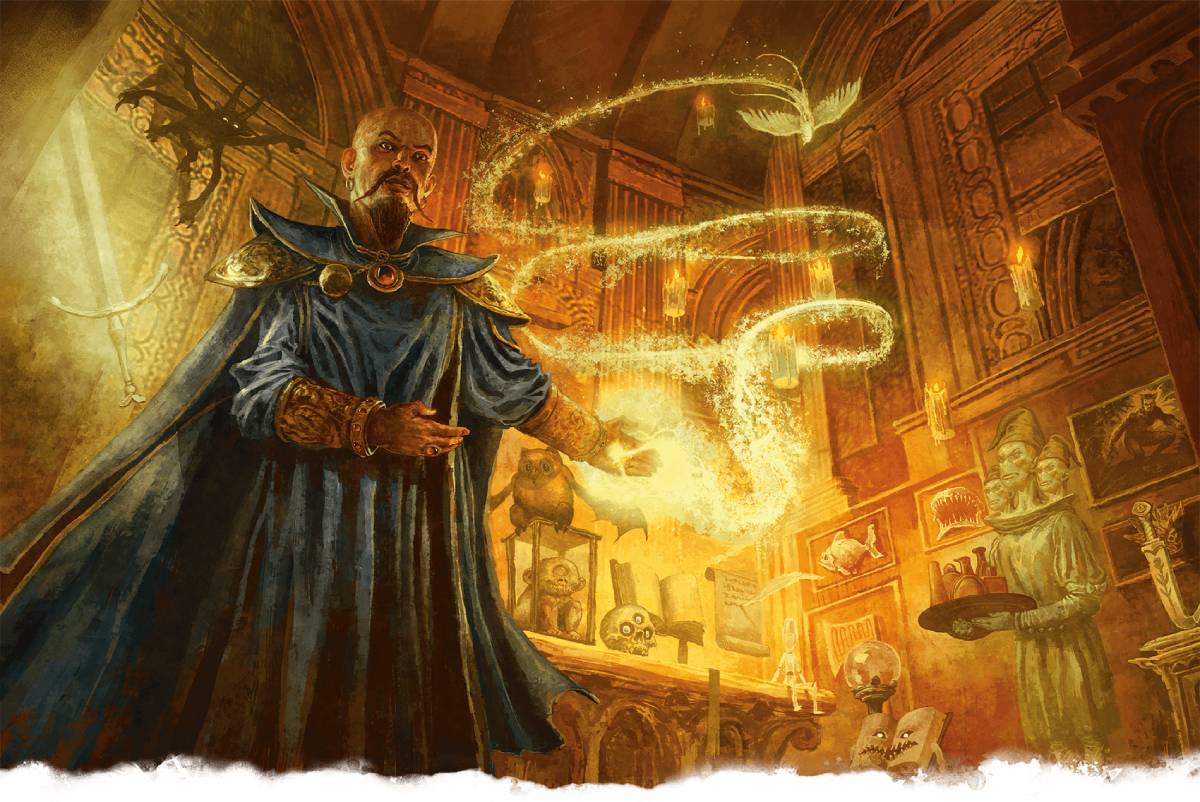
Neutral characters have no particular alignment towards good or evil, nor are they ruled by chaos or order. Neutral characters are pragmatic and will work towards whatever seems best at the time. Characters who serve as impartial observers tend to be Neutral. Similarly, characters whose main focus is on balance or preserving the natural order, with no specific emphasis on protecting anyone or pursuing selfish gain, are considered Neutral.
The archmage Mordenkainen is an example of a Neutral character. He is the founder and leader of the Circle of Eight, which he created to uphold his philosophy of balance across the multiverse.
Chaotic Neutral
A Chaotic Neutral character prizes their freedom above just about everything else. Their motivations are not cruel, but they’re not particularly interested in kindness either. Characters who are Chaotic Neutral are often described as “moving where the wind takes them.” Rakish scoundrels, roving gamblers, and a few anti-heroes would fall under this banner.
Returning to Baldur’s Gate 3, Astarion begins the game as a Chaotic Neutral character. When he’s first encountered in the game, he’s free for the first time in centuries. His primary drive is to remain free, and he supports decisions that serve that goal. He can be pushed towards good or evil based on choices you make as a player, but the initial cobblestones of either path are paved with his desire to protect and empower himself.
Lawful Evil
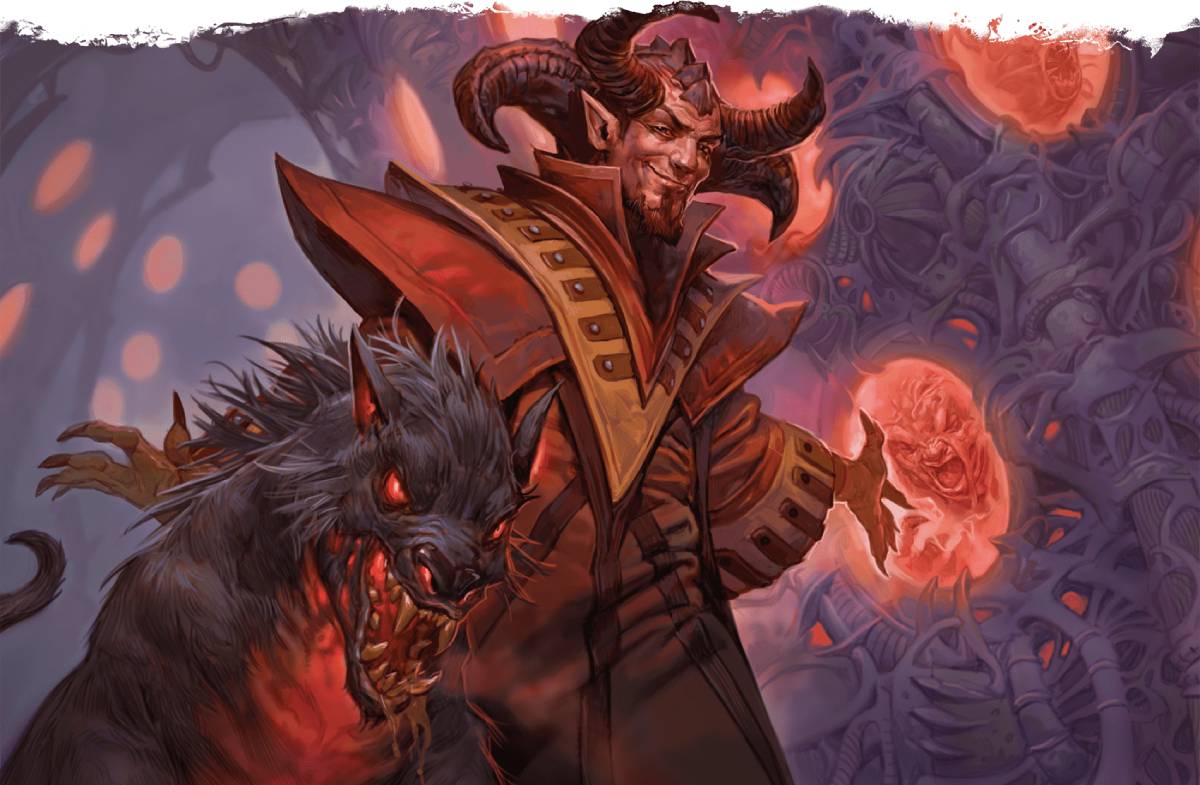
Lawful Evil characters empower themselves by using rules, laws, and binding contracts. Examples of Lawful Evil creatures are dictators who impose tyrannical laws or cult leaders who force restrictive tenets on their followers.
Devils, the quintessential inhabitants of the Nine Hells, are often Lawful Evil. They have defined hierarchies and amass power through complicated contracts and cunning deals.
Neutral Evil
Neutral Evil characters pursue their own desires and ambitions without caring at all for the harm it might cause others. They think nothing of putting a whole population of people in danger if it gets them the things they want, such as wealth or power.
Acererak, the infamous lich and architect of deadly tombs, is an example of a Neutral Evil character. He operates without regard for law or chaos, focusing solely on his relentless pursuit of power and immortality. He traps adventurers in his dungeons for his own gain and is entirely unbound by allegiance to any higher principle or authority beyond his ambitions.
Chaotic Evil
Characters that are Chaotic Evil harm others without hesitation and may even go out of their way to do so. They might do this out of bloodlust, out of hatred, or just a general desire to watch the world burn. Characters who kill with reckless abandon or spite tend to be Chaotic Evil.
Demons in D&D are Chaotic Evil engines of destruction, originating from the multiversal embodiment of all things perverse and gruesome—the Abyss. Demons follow no rules or hierarchy, opting instead for sowing chaos in every form. Outside of the D&D universe, the Joker or Mr. Hyde serve as strong examples of Chaotic Evil villains.
Aligned For You
Like your character’s class, species, and background, their alignment is a piece of the overall puzzle that makes up who they are and how they react to situations.
Alignment enables you to know how a character interacts with the morality of their world and how likely they are to follow (or completely ignore) the rules set before them. While a character’s alignment can change and isn’t a restrictive definition of your character, it acts as a guiding light for their ethical attitudes and ideals.

Riley Silverman (@rileyjsilverman) is a contributing writer to D&D Beyond, Nerdist, and SYFY Wire. She DMs the Theros-set Dice Ex Machina for the Saving Throw Show, and has been a player on the Wizards of the Coast-sponsored The Broken Pact. Riley also played as Braga in the official tabletop adaptation of the Rat Queens comic for HyperRPG, and currently plays as The Doctor on the Doctor Who RPG podcast The Game of Rassilon. She currently lives in Los Angeles.








-
View User Profile
-
Send Message
Posted Dec 14, 2024This approach describes not the characters, but their relations with the outside world, and thus relies on both, ending up being relative. Being lawful in Menzoberranzan and lawful in Waterdeep is two very different things.
I rather just treat good as altruistic and evil as egoistic, lawful as methodical and chaotic as impulsive. That way it describes the characters independent of cultural context.
-
View User Profile
-
Send Message
Posted Dec 14, 2024Astarion... Chaotic Neutral? Did... Did we play the same game? Like, in the official material he's stated as being evil (ya know, like a Vampire Spawn do). Same with Lae'zel, Githyanki are servants of Tiamat in addition to their lich queen, they are, by definition, Lawful Evil. Like... Johnny...
I... don't think we played the same game.
-
View User Profile
-
Send Message
Posted Dec 14, 2024Did the author even study the 5th edition of D&D, where vampire spawn are always Neutral EVIL? After such a mistake, trust in the ENTIRE article is diminished
-
View User Profile
-
Send Message
Posted Dec 14, 2024I feel like chaotic evil doesn't have to be murder hobos tho, I find it can also be fun to play them kinda like extreme versions of neutral characters. Just my personal opinion what r y'all's thoughts?
-
View User Profile
-
Send Message
Posted Dec 14, 2024I won't lie, I just had an epiphany when trying to figure out how to argue against methodical and impulsive. The alignments are all about the motivations behind the actions that are taken and I admit I now think I was looking at law and chaos from the wrong perspective. If we analyze the emotions behind each alignments actions, it is clear to me that good beings act as they do out of empathy and compassion while evil ones act out of greed and desire.
But what emotions govern the difference between lawful and chaotic? Lawful by its very nature is order above all else while chaos as the opposite of order is spontaneity. I was struggling with this as I tried to reason though this while trying to avoid outside influences and focus on the individual. And then it struck me that I was looking at it from the wrong perspective. Law is the absence of emotion while chaos is the embracing of it! Thus similar to good being altruistic and evil being egoistic, lawful is logic while chaos is emotion.
Thus applying this new perspective to the alignments results in the following:
Lawful Good - Help others not because it feels good, but because it is just and right.
Lawful Neutral - There is no ambiguity. Every thought has its reason and every action has its consequence.
Lawful Evil - No matter what transgression they have committed, it was never personal.
Neutral Good - Be kind and charitable to those that are less fortunate.
Neutral - Act accordingly as context matters and nothing is black and white.
Neutral Evil - No one else matters. The world really does revolve around them.
Chaotic Good - The greatest guilt comes from failure to act when one can save someone from suffering and need.
Chaotic Neutral - Live in the moment and care not for the opinions and expectations of others.
Chaotic Evil - Act according to emotions and desires without hesitation or guilt.
-
View User Profile
-
Send Message
Posted Dec 14, 2024Chaotic evil are not murder hobos. But murder hobos are chaotic evil. Being chaotic evil just means that you will pursue what ever desire or fancy meets your whim regardless of logical reasoning or consequence to others. It just so happens that to cause suffering to others for your own benefit is evil and to act on your own emotions with no hesitation or premeditation is chaotic. The combination of these two extremes results in someone that will lash out at someone with no hesitation or forethought the very second they feel they have been wronged in some way. This alignment will also include those that derive pleasure from suffering which to most people is the definition of true evil in a moral sense.
Thus when one commits a crime of passion, it is an act of chaotic evil. Thus to be aligned to chaotic evil in a more general sense means that one often reacts emotionally in such a way that doesn't consider the harm dealt to others in the moment of the act. Whether this is someone who suddenly punches another passerby on a street for thinking they were looked at wrong or someone who derives twisted pleasure from committing acts of horrendous depravity, these are both actions done for emotional reasons with no regard for harm to others. Just one is far more extreme then the other.
-
View User Profile
-
Send Message
Posted Dec 15, 2024The way I see order can be summarized as "If you have to break the rules to win then you aren't winning, you're just breaking the rules." The Lawful believes and probably with some correct reasons that if one doesn't work within the existing framework of the society or organization to which they belong then any change is likely to be reversed and deemed deviant because it dispensed with the existing norms. In the framework of a constitutional republic this would be an executive attempting to legislate by decree only to have that decree overturned by their own legislature and the executive facing censure for not going through the established legislative process. Lawful cares about order regardless of the moral dynamic driving it.
Chaotic types I see more as fierce individualists rather than just whim driven personalities which is how they have been portrayed in the examples over several editions. Can Chaotic types be whim driven? Yes, do they need to be? No, no more than Lawful needs to be unquestioningly obedient to an authority figure. Was I overly simplistic in my initial query regarding the law vs chaos matter, yes. That however was my point, there needs to be a way to convey these complex concepts in a quick and simple way to players as easily as we do with the attributes listings.
-
View User Profile
-
Send Message
Posted Dec 16, 2024The simplest way is to list personality traits associated with the different alignments so that characters can see how these different alignments behave on an individual decision making level. It seems to be pretty agreed upon that altruistic represents good while egoistic represents evil. Applying the version of lawful and chaotic I arrived at is summed up as logical versus emotional.
If we are to apply both positive and negative personality traits to these representations, we arrive at the following;
Typical positive personality traits for good would be compassionate, empathetic, and caring while negative traits could be naivety, codependency, and self-neglect. Positive evil traits would be self-aware, motivated, and resilient while negative traits would be apathetic, self-centered, and exploitative. Positive traits for lawful would be cautious, meticulous, and disciplined while negative traits would be controlling, inflexible, and indecisive. Positive traits of chaotic would be free-spirited, laid-back, and adaptable while negative traits would be impulsive, reckless, and unorganized.
Several of these traits I came up with to describe how I see the behaviors of each alignment seem to be in agreement with the associated traits in the player's manual. This makes me confident that I am on the right track with my thinking on how to view the alignments. The Good-Evil axis seems to govern the motivation for the decisions one would make (being whether they act solely in their own self interest or take into account the consequences to others). The Lawful-Chaotic axis on the other hand seems to govern the process that goes into their decision making (planned course of action where you consider every outcome versus an emotional response in the heat of the moment where you go with a gut feeling).
-
View User Profile
-
Send Message
Posted Dec 19, 2024I think one of the caveats here is that alignment isn't self-assigned. We're outside observers here with an "objective" view on the circumstances. This article does well at explaining which alignments would be applied to which actions. The entire point of the article isn't about telling you what's good or bad, it's telling you that based on certain "objective" actions, an alignment can be associated with those actions.
This isn't about what is "good" or "evil, or "selfish" or "selfless", I've always viewed alignment as "based on the actions you've taken, would the people on the prime material plane describe your actions as good or bad".
Alignment really hasn't impacted 5e nearly as much as it did in earlier editions. Granted, I believe PC's shouldn't have an alignment. I think alignment is a DM tool to understand a creature's motivations in two letters in a stat block. PC's are supposed to have more depth than monsters and NPC's you meet. Instead of an alignment, I think PC's should have their own motivations, bonds, and ideals that they follow (which may in the end be similar to an alignment), however characters and their motivations can change through the course of play, just like alignment.
-
View User Profile
-
Send Message
Posted Dec 20, 2024The main issue I have with this is that people on the prime material plane will not agree on what alignment a particular action belongs to. Even the Drow that serve Lolth in the Underdark believe in right and wrong, but an action they would see as good is very different from what a human in Baldur's Gate would see as good. Whether it is an outside objective observer looking in, an entity viewing the action from across the planes, or a fellow adventurer seeing the act firsthand, their view on the alignment of that act is tainted with their own understanding of that the alignments represent. This is why I believe the alignments lie not in the act, but the motivation for doing the act. Alignment is a narrative tool that allows a DM or player to figure out how a particular character might react to a situation when that character might behave differently to how they themselves think. It is not necessary to use in a campaign depending on how each player acts out their own characters or how the DM wishes the players to view the acts of another NPC.
Regardless, I believe alignment becomes far to muddled by trying to view it from any objective nature. Alignment fuels the decision making process and a definition that avoids morality or any other outside view should be avoided. Law is all about order and order existed when everything has a purpose. Thus on the individual decision making level being lawful is about finding that purpose in every decision. The epitome of lawful when choosing how to act is to think before your act. Every decision must be made by first weighing all the possible consequences. Chaotic decision making is to act in the spur of the moment. The epitome of chaotic is to never hesitate to act. Sometimes one must simply act as they do not always have time to weigh the consequences. Similarly, a good person is willing to sacrifice their own time, resources, health, and freedom for the sake of others while an evil person is willing to sacrifice the time, resources, health, and freedom of others for the sake of themselves.
-
View User Profile
-
Send Message
Posted Jan 7, 2025Deleted
-
View User Profile
-
Send Message
Posted Jan 7, 2025While vampire spawn are usually neutral evil, there are always exceptions. That’s like saying “all drow are evil” because that’s what the monster Manuel says.
-
View User Profile
-
Send Message
Posted Jan 8, 2025No, they are drinks. (Sorry I had to make that terrible joke.) 😀
-
View User Profile
-
Send Message
Posted Feb 2, 2025Devils will take your words and interpret them in the worst (for you) way to do what they want, they are Lawful Evil.
Fey will take your words and interpret them in the worst (for you) way to do what they want, they are Chaotic Good.
How does that make any sense? I don't know.
-
View User Profile
-
Send Message
Posted Feb 3, 2025Devils act the way they do with mortals because their entire society is built on a chaste system where the only way to move up in their world is to collect magical energy from corrupted mortal souls. Their trickery is done with the intent to gain more corrupted souls and thusly improve their station in life.
Fey act the way they do as all they are doing is finding ways to amuses themselves. Many fey do not consider their trickery to be evil and intend no harm. Now that said, you imply that fey in general are chaotic good which is not true at all. After all, members of the Unseelie court, hags, and redcaps are certainly evil. All fey usually employ trickery and deception, but some are just for the sake of causing pranks while others are much more devious in intent.
On a final note, I think too many people get caught up in discussing the alignment associated with a particular act. But the act itself does not inherently belong to any specific alignment. What is important is the motivation behind the act. Was the act lawful because it was reasoned and planned out? Or was it chaotic because it was done at a whim in the spur of the moment? Was the act good because it was intended to help others? Or was it evil because the act was done despite knowing that it would cause harm to others? It is these questions regarding the motivations behind the actions that matter when dealing with alignments. Both a good individual and an evil individual can give charity to those in need. Just one does it because they want to improve the lives of those that are less fortunate while the other simply wants you to believe they care about those in need.
-
View User Profile
-
Send Message
Posted Mar 6, 2025Shrek was never Neutral Evil in the beginning. He never sought to actively hurt anyone and get joy or pleasure out of it. He was true Neutral. He didn't care about anything (The kingdom's politics or peoples) one way or the other than just for them to stay out of his swamp and leave him alone.
-
View User Profile
-
Send Message
Posted Apr 2, 2025I feel that explaining the moral principles of good and evil would make for a much, much larger post. Riley only has so much time. I feel this is the general "good and evil" scheme in D&D, as it is commonly used as an incentive for players to hate an NPC, or their actions, without understanding their full implications. I understand your complaint, but don't shoot that at one of the best D&D Beyond posters. Make your own philosophical campaign and make a new alignment map yourself. Thank you. Also, this is directed at Reign_Fiend, not P4R4D153_39989.
-
View User Profile
-
Send Message
Posted Apr 16, 2025Look in Mordenkainen presents: monsters of the multiverse, then go and look at some devils, it will say typically lawful evil
-
View User Profile
-
Send Message
Posted May 27, 2025What alignment would a elf ranger/rogue anti hero be?
-
View User Profile
-
Send Message
Posted Sep 3, 2025It is completely up to you. Races/classes do not define alignment